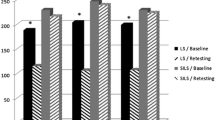Abstract
Background
Different types of single-incision laparoscopic surgery (SILS) have become increasingly popular. Although SILS is technically even more challenging than conventional laparoscopy, published data of first clinical series seem to demonstrate the feasibility of these approaches. Various attempts have been made to overcome restrictions due to loss of triangulation in SILS by specially designed SILS-specific instruments. This study involving novices in a dry lab compared task performances between conventional laparoscopic surgery (CLS) and single-port laparoscopic surgery (SPLS) using newly designed pre-bent instruments.
Methods
In this study, 90 medical students without previous experience in laparoscopic techniques were randomly assigned to undergo one of three procedures: CLS, SPLS using two pre-bent instruments (SPLS-pp), or SPLS using one pre-bent and one straight laparoscopic instrument (SPLS-ps). In the dry lab, the participants performed four typical laparoscopic tasks of increasing difficulty. Evaluation included performance times or number of completed tasks within a given time frame. All performances were videotaped and evaluated for unsuccessful attempts and unwanted interactions of instruments. Using subjective questionnaires, the participants rated difficulties with two-dimensional vision and coordination of instruments.
Results
Task performances were significantly better in the CLS group than in either SPLS group. The SPLS-ps group showed a tendency toward better performances than the SPLS-pp group, but the difference was not significant. Video sequences and participants` questionnaires showed instrument interaction as the major problem in the single-incision surgery groups.
Conclusions
Although SILS is feasible, as shown in clinical series published by laparoscopically experienced experts, SILS techniques are demanding due to restrictions that come with the loss of triangulation. These can be compensated only partially by currently available SILS-designed instruments. The future of SILS depends on further improvements in the available equipment or the development of new approaches such as needlescopically assisted or robotically assisted procedures.







Similar content being viewed by others
References
Rivas H, Varela E, Scott D (2010) Single-incision laparoscopic cholecystectomy: initial evaluation of a large series of patients. Surg Endosc 24:1403–1412
Stolzenburg JU, Kallidonis P, Hellawell G, Do M, Haefner T, Dietel A, Liatsikos EN (2009) Technique of laparoscopic-endoscopic single-site surgery radical nephrectomy. Eur Urol 56:644–650
Marks J, Tacchino R, Roberts K, Onders R, Denoto G, Paraskeva P, Rivas H, Soper N, Rosemurgy A, Shah S (2011) Prospective randomized controlled trial of traditional laparoscopic cholecystectomy versus single-incision laparoscopic cholecystectomy: report of preliminary data. Am J Surg 201:369–372 discussion 372–373
Kaouk JH, Autorino R, Kim FJ, Han DH, Lee SW et al (2011) Laparoendoscopic single-site surgery in urology: worldwide multi-institutional analysis of 1,076 cases. Eur Urol 60(5):998–1005
Santos BF, Enter D, Soper NJ, Hungness ES (2011) Single-incision laparoscopic surgery (SILS™) versus standard laparoscopic surgery: a comparison of performance using a surgical simulator. Surg Endosc 25:483–490
Santos BF, Reif TJ, Soper NJ, Hungness ES (2011) Effect of training and instrument type on performance in single-incision laparoscopy: results of a randomized comparison using a surgical simulator. Surg Endosc 25:3798–3804
Brown-Clerk B, de Laveaga AE, Lagrange CA, Wirth LM, Lowndes BR, Hallbeck MS (2011) Laparoendoscopic single-site (LESS) surgery versus conventional laparoscopic surgery: comparison of surgical-port performance in a surgical simulator with novices. Surg Endosc 25:2210–2218
Islam A, Castellvi AO, Tesfay ST, Castellvi AD, Wright AS, Scott DJ (2011) Early surgeon impressions and technical difficulty associated with laparoendoscopic single-site surgery: a Society of American Gastrointestinal and Endoscopic Surgeons learning center study. Surg Endosc Feb 27. Epub ahead of print
Nagele U, Walcher U, Herrmann TR (2011) Initial experience with laparoscopic single-incision triangulated umbilical surgery (SITUS) in simple and radical nephrectomy. World J Urol (in press)
Nicolay LI, Bowman RJ, Heldt JP, Jellison FC, Mehr N, Tenggardjaja C, Millard W, Koning JL, Baldwin DD (2011) A prospective randomized comparison of traditional laparoendoscopic single-site surgery with needlescopic-assisted laparoscopic nephrectomy in the porcine model. J Endourol 25:1187–1191
Barret E, Sanchez-Salas R, Ercolani M, Forgues A, Rozet F, Galiano M, Cathelineau X (2011) Robotic-assisted laparoendoscopic single-site surgery (R-LESS) in urology: an evidence-based analysis. Minerva Urol Nefrol 63:115–122
Acknowledgments
We thank Karl Storz, Tuttlingen, Germany for providing the instruments and technical support for this study.
Disclosures
Arkadiusz Miernik has a consultant contract with OptiMed Medical Instruments GmbH, Ettlingen, Germany. Wojciech Konrad Karcz has a consultant contract with Covidien Deutschland GmbH, Fellbach, Germany. Martin Schoenthaler, Kerstin Lilienthal, Alexander Frankenschmidt, and Simon Kuesters have no conflicts of interest or financial ties to disclose.
Author information
Authors and Affiliations
Corresponding author
Additional information
Arkadiusz Miernik and Martin Schoenthaler contributed equally to this work.
Rights and permissions
About this article
Cite this article
Miernik, A., Schoenthaler, M., Lilienthal, K. et al. Pre-bent instruments used in single-port laparoscopic surgery versus conventional laparoscopic surgery: comparative study of performance in a dry lab. Surg Endosc 26, 1924–1930 (2012). https://doi.org/10.1007/s00464-011-2129-8
Received:
Accepted:
Published:
Issue Date:
DOI: https://doi.org/10.1007/s00464-011-2129-8




